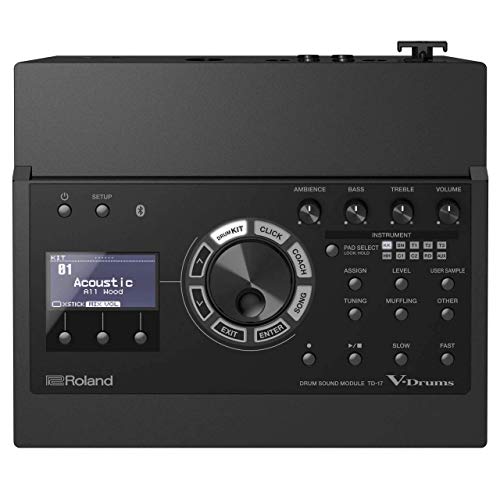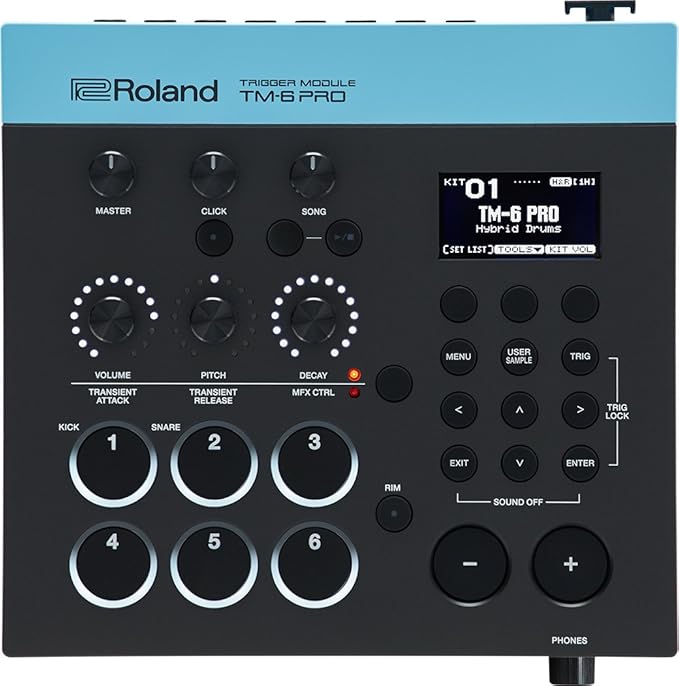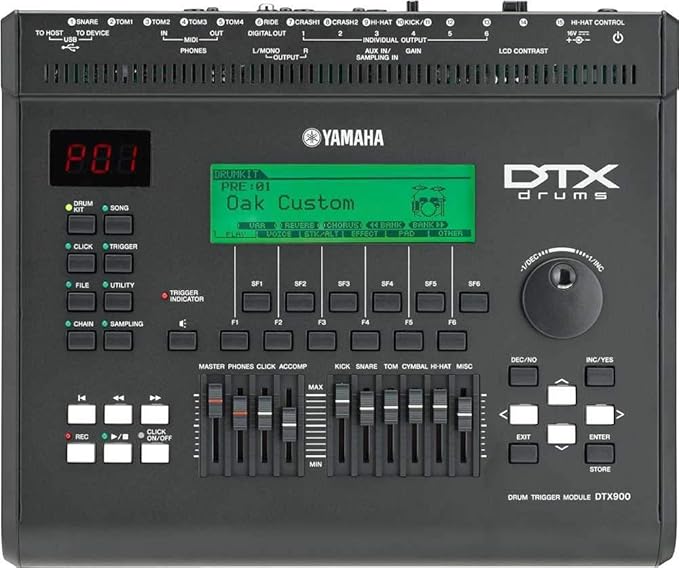Last Updated on October 28, 2021 by Danny
The drum module is the brain of any electronic drum kit. It is the most crucial part as it converts your drum strokes into the music you hear. It is essential to choose the right drum module for your kit as a bad one can ruin your drumming experience. We have listed some of the best electronic drum modules from the market, everything from the most premium ones to the more affordable options. Each of these options will provide you excellent value for money.
7 Best Drum Modules of 2021
| Image | Product | Features | Price |
|---|---|---|---|
 | 1. Pearl MIMP24B Mimic Pro |
| Check Latest Price |
 | 2. Roland V-Drums TD-50 Drum Sound Module |
| Check Latest Price |
 | 3. Yamaha DTX502 Electronic Drum Trigger Module |
| Check Latest Price |
 | 4. Roland TM-6 PRO Acoustic Drum Trigger Module |
| Check Latest Price |
 | 5. YAMAHA DTX900 ELECTRONIC DRUM TRIGGER MODULE |
| Check Latest Price |
 | 6. Roland TD-17 Drum Sound Module |
| Check Latest Price |
 | 7. Yamaha EAD10 Electronic-Acoustic Drum Module |
| Check Latest Price |
1. Pearl Mimic Pro Drum Module – Best Overall
The Mimic Pro from Pearl is the direct competitor of Roland’s TD-50, and it can stand toe to toe with it as one of the best drum module ever. It is a collaboration between Pearl and Steven Slate and is a game-changer. It comes with 60 different drum sets from Steven Slate Drums 5 library and uses high-quality 24-bit audio, something that’s new to the e-drumming world. It also features the Burr-Brown converter, which delivers incredible 3D realism. It also has ultra-low latency, which means there will be no delay between striking and hearing the sound.
The one place where the Mimic obliterates the TD-50 is in ease of use, as the Mimic’s 7″ touchscreen interface allows you to navigate and change settings effortlessly. It comes with a 120 GB SSD and SD/USB ports, so you will be able to store all your high-quality samples without any issue.
This module has 16 trigger inputs and outputs, so you will be able to play even the biggest kits with this single module. You won’t have to buy brand new pads from Pearl as it is compatible with almost all the triggers from major manufacturers. It also has advanced sensor technology that reduces false triggering. The Mimic Pro is one of the best electronic drum modules to use at live performances due to its quick response time and versatility. If you are a serious drummer like me, I highly recommend this.
2. Roland V-Drum TD-50 Drum Module – Runners-up
Roland TD-50 is the Creme De La Creme of drum modules. It comes with 55 preset kits, but you will get an additional 20 new kits if you update the firmware. You can also add your sounds and create custom drum sets. The Roland TD-50 has a lot of customization ability that lets you alter the sound to your desire. The Prismatic Sound Modelling engine gives you excellent quality and expressiveness.
TD-50 is an advanced module that allows you to control room reverb, compression, saturation, and even EQ directly from the module. It also allows you to store snapshots of your kit before tweaking. This level of extensive control is ideal for professionals, and the price is as such. The build quality is also the very best. It looks incredible and should last for a very long time.
It has 17 trigger inputs and about eight direct outputs, most for any drum module; it even has an SD card out. You can also record ten channels over USB without any additional equipment. The TD-50 is one of the best electronic drum modules globally, making it a perfect choice for professionals.
3. Yamaha DTX502 Electronic Drum Trigger Module – Value for money
The DTX502 comes loaded with nearly 700 samples and 50 different kits. Each of the sound samples has been designed by some of the best VST developers and sound impeccable. The DTX502 comes loaded with 37 different songs to which you can play along. You can also add additional play-along songs using its USB port. This module is filled with an array of educational capabilities, making it great for beginners.
It has eight different training methods,such as the Groove Check that helps you improve rhythm and the Pad Gate that lets you learn new patterns. All the sounds of the kit are programmable, you can change the tuning, stereo panning, decay, and volume among other settings.
The interface is straightforward, and it only has a small LCD screen, a data wheel, and buttons. However, even though it has a simple interface, it can still import MIDI files and has USB connectivity. You can connect up to 12 trigger inputs to this. What makes this module a great buy is that it offers excellent features at an affordable price.
4. Roland TM-6 PRO Drum Module
This drum module has over 500 samples and about 80 different Roland V-drum sets. You can also add your samples and even extensively alter the preloaded sounds. It comes with knobs that control the volume, pitch, and other settings. There are also plenty of other buttons and a compact LED screen to help you alter settings. It also has hi-hat pedal control, something that previous generations of Roland lacked.
It has six trigger inputs, but you can extend it to 12 using a separate Y-cable. However, the number of output busses are a little limited, so integrating backing tracks for performances is a little complicated. This drum module is excellent for hybrid drum setups. The TM-6 also has a Set List feature that lets you scroll through inbuilt kits in the order you want using either the +/-buttons or a footswitch.
The build quality is excellent, and it has a compact design. It also has an SD card slot through which you can add the custom samples. You can also add click tracks and backing tracks using the SD card. The interface is straightforward to use; however, the price is relatively high for the set of features. Overall TM-6 is the best Roland drum module for the money.
5. Yamaha DTX900 Electronic Drum Module
The DTX900 is Yamaha’s most premium offering. It runs on Yamaha’s revered 64-tone polyphonic generator that gives great sounds that feel natural. The kit comes with thousands of professional sounds and 50 preset drum kits. You can also add another 50 of your custom user kits if you desire. This can also handle up to 15 individual trigger inputs and can have up to six outputs.
The layout does not deviate from Yamaha’s traditional one and is quite user friendly. It comes with plenty of analog controls and knobs that let you fine-tune all your sounds. This module is also an excellent practice unit, primarily due to its inbuilt music sequencer. There are many presets songs where you will be able to mute a specific instrument or drum. Therefore you will be able to play along with the devices and improve yourself.
It even has an inbuilt metronome, a rhythm gate, and a groove check feature. It has both MIDI input and output, dual-track real-time recording, and both USB-A and USB-B ports. Even though this module is packed with advanced features, it costs lower than its competitors.
6. Roland TD-17 Drum Sound Module
The TD-17 is an excellent module for beginners and intermediate drummers. This module’s sounds are based on the TD-50’s Prismatic sound engine, so it has high-quality sounds that sound natural. It also has comprehensive editing options that let you create your own signature drum set. It comes inbuilt with 50 preset kits and you can add 50 more of your own. It even has an SD card slot that can be used to add your own samples and backup your custom kits and recordings.
It comes with a slew of coaching features that will let you significantly improve as a drummer. It has both USB and MIDI connectivity. You can also layer and mix quite easily with this module. However, the unique part is that it even has Bluetooth connectivity. You can pair your smartphone with the Roland TD-17 and play along with drum lessons on your phone; the module even comes with a phone stand. While this is primarily targeted at beginners, it is still a great product for experienced drummers on a budget.
7. Yamaha EAD10 Acoustic Drum Module
EAD10 is an excellent way for you to enhance your drumming experience. It is one of the easiest ways to turn your acoustic drum into an electronic one. It comes preloaded with 50 presets, and you can add up to 200 of your own presets. It has high-quality samples and plenty of studio-grade digital effects. You can also add up to three additional triggers along with the inbuilt one.
The EAD10 is incredibly easy to set up and allows you to create hybrid kits without much hassle. There is a headphone jack if you want to listen by yourself, but it also has left and right main outputs that let you plug it into a PA system.
You will be able to play along to your favorite tracks and even record yourself for self-analysis and sharing. There is a companion app released for this, and it will allow you to record and store your tracks on your mobile. The app is only there for iOS devices, so Android users might wanna think twice before getting this. However, You can also store them in a USB drive.
Electronic Drum Module Buying Guide
Does it allow recording to store your own selection of kits?
A few drum modules allow the user to record their custom sounds and make a custom kit out of these sounds. You can record anything from the sound of your keys jingling to the clunk of your local church’s bell. This feature is typically only limited to professional modules, as most beginners will not have much use for this. As a professional drummer, you will get an unlimited supply of different sounds to mold into any genre.
Number of drum sounds the module comes loaded with (Sound Library)
The sound library is the storehouse of all the sounds that you hear from the drums pads. Cheap kits will usually have about a hundred samples, while premium kits can have over a thousand. It is not just about numbers, though; the quality of the sound samples also matters. Premium drums get better quality sounds samples as you would expect.
The cheaper electronic kits are better for beginners as they won’t be overwhelmed by the number of samples. The premium kits are only suitable for professionals as only experienced drummers will make full use of the vast libraries. The premium electronic sets also allow users to add their custom samples to the library.
Preset kits
These modules usually come with many different preset kits for you to choose from. While several preset kits are essential, you should look into what are other preset kits available. Think about the different genres you are interested in playing and see if the module comes with kits suitable. These modules usually feature kits from many genres, so you can test out drums from genres you aren’t used to. The more expensive drums tend to have the widest variety of preset kits, but a low-cost module with just half a dozen standard preset kits will be enough for a beginner.
Pad Materials
Drum pads can be made from a variety of different materials. The two most prominent options in the market right now are rubber and mesh.
Rubber is the cheapest option in the market. They are durable and can absorb a significant amount of volume. However, they feel a little unnatural, and you usually have to put in more force to register a strike.
Mesh was initially restricted to only Roland, but nowadays, many manufacturers make mesh pads. These pads have many advantages over rubber ones. They are lighter, quieter, and most importantly, feel more realistic than rubber ones. By natural feel, we mean that the drums feel similar to an acoustic kit. Therefore, many of the best electronic drums in the market use mesh. The only drawback is that these cost more than rubber. However, there are a few cheap mesh pad offerings.
Silicon is a much less prevalent option. These are halfway between rubber and mesh pads in both feel and price.
Number of Pieces
The number of pieces is the total number of input triggers a drum module can take. Decide the number of pieces you need by counting the number of drums and cymbals you want to use. Add two or three to this number to ensure that you have an option to expand in the future. A standard module usually has eight input options.
Number of Response Zones
The number of response zones significantly affects playability. The pads can be either mono or multi-zones. Mono-zone pads have only one zone and produce the same sound, regardless of whether you hit in the center or the edge of the pad. A multizone pad, on the other hand, produces different sounds based on where you strike. Multizone ones typically have two zones, but high-end models can even have three zones. Having more response zones gives you better control of the sound you produce, thereby boosting playability.
Input /Output Options
Electronic sets usually do not come with inbuilt speakers, so you will need headphones or speakers to listen to the music you are producing. Most electronic kits have a headphone jack to allow you to hear easily. You might also need an amplifier to boost the sound in the speakers.
Many modules also allow you to plug in USB drives as input. You can load it with songs and able to practice and play your favorite track. They can also contain custom sound samples that you can add to the module’s sound library.
Electronic Drum modules typically have a MIDI output connected to your computer using a USB cable. You can also connect it to digital audio interfaces in the same way. Some modules even have multiple outputs, so you can simultaneously send output to both a recorder and a mixer. However, unless you are a professional drummer, you won’t be using this feature a lot.
Also Read: The 6 Best Drum Triggers for Acoustic Drums
What is a drum module used for?
The drum module used as the central processing unit and sound storage for an electronic kit. It creates, stores, and alters the various sounds selected by the drummer. The module cannot play any sounds, but it sends the signals to the speakers that play the sound. In addition to being used as the central piece in an electronic kit, drum modules are being increasingly used to convert acoustic kits into hybrid kits that combine the best of both worlds.
Also Read: Best High Quality Xlr Cable
Conclusion
The drum module is the most crucial piece in any electronic drum set, so it is important that you choose the best drum module for you. If you are a professional with thousands of dollars to spend, you cannot go wrong with the TD-50 or the Mimic Pro as these are the best in the market.
However, if you are someone with a limited budget and have only just begun your drumming journey, the TD-17 is a great option that provides good value for money due to its low cost and formidable set of features. Choosing the best one ultimately comes down to you, so think about what are your needs and choose wisely.






